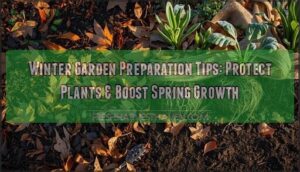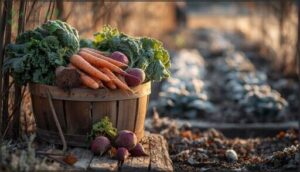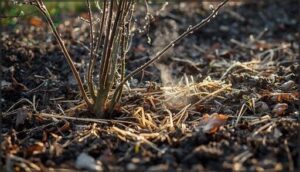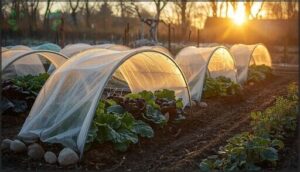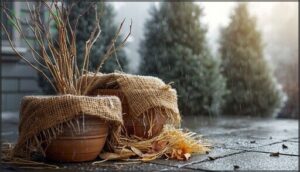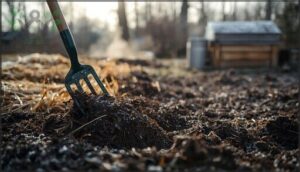This site is supported by our readers. We may earn a commission, at no cost to you, if you purchase through links.
Most gardeners wait until the first frost hits to start thinking about winter prep—and by then, they’ve already lost half the battle. The secret to a thriving spring garden isn’t what you do in March; it’s the work you put in during those crisp autumn weeks when the growing season winds down.
A garden that enters winter unprepared faces compacted soil, frost-heaved roots, and pest larvae tucked into plant debris, all waiting to sabotage next year’s harvest. Your fall tasks determine whether you’ll spend spring playing catch-up or watching your beds burst with vigorous growth.
From timing your mulch application to protecting vulnerable perennials, strategic winter garden preparation tips turn cold-weather dormancy into your garden’s most productive reset.
Table Of Contents
- Key Takeaways
- When to Start Winter Garden Preparation
- Harvesting and Storing Late-Season Crops
- Protecting Plants From Frost and Cold
- Soil Care and Improvement for Winter
- Planning and Organizing for Spring Success
- Frequently Asked Questions (FAQs)
- How do I prepare my garden for winter?
- How can I Keep my Garden in a good shape during winter?
- How do I prepare my garden soil for winter?
- Can You winterize your garden?
- What are winter gardening guidelines?
- How to prepare garden soil for winter?
- How do I succeed in winter gardening?
- What is winter gardening?
- What should I be doing in my garden in winter?
- What month do you start a winter garden?
- Conclusion
Key Takeaways
- Timing your winter prep around your local frost date—rather than waiting until after the first freeze—prevents soil compaction, pest problems, and root damage that can cut next season’s yield by up to 30%.
- Strategic mulching with 2-4 inches of organic material after the ground cools stabilizes soil temperature, prevents erosive freeze-thaw cycles, and delivers the root insulation that separates thriving spring gardens from struggling ones.
- Crop rotation mapped during winter’s downtime can boost yields by roughly 20% compared to planting the same families in identical spots, while fall soil amendments have four to six months to correct pH before spring planting begins.
- Protecting what stays behind—through frost cloths for tender perennials, container insulation for potted plants, and debris removal to break pest cycles—turns cold-weather dormancy into your garden’s most productive reset period.
When to Start Winter Garden Preparation
Getting your garden ready for winter isn’t something you can tackle on a whim—timing makes all the difference between protecting your plants and scrambling when frost arrives. The when depends on what you’re growing, where you’re gardening, and what tasks need your attention first.
Let’s break down how to time your winter prep so nothing catches you off guard.
Timing for Different Plant Types
Before your first frost arrives, you’ll need to winterize your garden based on plant hardiness and growth cycles. Cool-season vegetables like kale go in about eight weeks before frost, while garlic plants right at frost time. Perennials enter winter dormancy naturally, but flowering shrubs require seasonal pruning—avoid cutting old-wood bloomers in winter or you’ll lose next year’s blooms. Mulch protects roots through freeze-thaw cycles.
To prepare your garden for the cold season, consider using proper soil enrichment methods to boost spring growth.
Assessing Your Local Climate
To winterize your garden effectively, start with climate zone mapping—check the USDA hardiness zone for your area and note your average frost dates. Most zones shifted warmer in the 2023 update, affecting seasonal plant care timing.
Track temperature thresholds and monitor local weather patterns, since microclimates near walls or water can alter frost risk by several degrees, giving you better climate control over winter gardening tips.
Understanding your area’s hardiness zone map is vital for making informed decisions about plant selection and care.
Scheduling Key Garden Tasks
Once you know your frost date planning benchmarks, map out a clear timeline. Remove spent crops within one to two weeks after the first killing frost to curb overwintering pests.
Schedule soil testing in autumn—it gives you four to six months for pH corrections before spring.
Complete major cleanup by late November, then focus on season extension setups, winter pruning, and crop rotation strategies for your seasonal gardening success.
Harvesting and Storing Late-Season Crops
Knowing what to harvest before the first hard freeze—and what can safely stay in the ground—makes all the difference in preserving your garden’s bounty. Different crops have different tolerances, and timing your harvest right protects both quality and flavor.
Here’s how to handle your late-season vegetables and get them ready for storage.
Identifying Frost-Sensitive Vegetables
Some vegetables crumble at the slightest chill, while others laugh off a hard freeze. Warm-season crops like tomatoes, peppers, beans, cucumbers, and squash have no frost tolerance—they’ll die when temperatures hit 32°F. You’ll find these tender vegetables need immediate harvest or protection before any frost warning.
Meanwhile, hardy types like kale, Brussels sprouts, and carrots can handle subfreezing conditions without flinching.
Harvesting Root Crops and Potatoes
Timing root crop harvesting right means pulling carrots, beets, and parsnips up to three weeks after the first frost—but before nighttime temperatures consistently drop below 30°F.
You’ll want to dig potatoes once vines die back on a dry day, using a garden fork to loosen soil gently and avoid cuts that invite decay. Brush off excess dirt rather than washing to extend storage life.
Proper Storage Methods for Produce
Root cellar storage works best when you match conditions to crop type. Keep carrots and beets at 32–40°F with 90–95% humidity, while onions and garlic need drier air around 60–70%.
Separate ethylene producers like apples from sensitive vegetables such as cabbage to prevent premature spoilage.
Proper produce handling and humidity control can extend your harvest’s life from weeks to months.
Protecting Plants From Frost and Cold
When temperatures drop, the right protection can mean the difference between a thriving winter garden and one that barely limps into spring. You’ve already harvested what needed to come in, but now it’s time to shield what stays behind.
Here are four essential strategies to keep your plants safe through the coldest months.
Mulching to Insulate Roots
Mulch acts like a blanket over your garden beds, stabilizing soil temperature and shielding roots from damaging freeze-thaw cycles. This layer provides essential root insulation, reduces frost heaving, retains moisture, and suppresses weeds—setting the stage for vigorous spring growth and effective winter garden care.
Apply 2 to 4 inches of straw, shredded leaves, or compost after the ground cools but before hard freezes begin.
Using Frost Cloths and Row Covers
When frost threatens, row covers and frost cloths offer measurable winter plant protection—think of them as portable insulation for your beds. Midweight AG-30 fabrics usually provide around 6°F of protection while transmitting roughly 70% of light, ideal for hardy greens and brassicas.
Install covers over hoops spaced 3 to 4 feet apart, securing edges tightly with soil or boards to trap warmth and extend your harvest weeks beyond the first freeze.
Bringing Tender Plants Indoors
Many tender perennials—geraniums, coleus, and rosemary—won’t survive even brief nights below 45°F and need timely indoor relocation to winterize garden efforts. Start your acclimation techniques by moving container plants to shade for a week, then shift gradually indoors.
Before entry:
- Inspect every leaf surface for aphids and spider mites using proper pest control methods
- Position plants near south-facing windows for adequate indoor lighting
- Monitor humidity management with trays, targeting 50–60% for tropical species
Shielding Container Plants
Container plants face a hidden risk: their roots experience near-air temperatures and freeze faster than in-ground neighbors. You’ll need container insulation to winterize garden pots effectively—group them together, then surround with straw or shredded leaves for root protection.
Add frost covers or burlap soil wrapping around bases, and maintain moist (not wet) mulch. This winter gardening tips approach prevents lethal damage below 20°F.
Soil Care and Improvement for Winter
Winter is the perfect time to give your soil some attention while your garden takes a rest. A few strategic steps now will set the stage for healthier plants and stronger growth come spring.
Let’s look at three key practices that keep your soil in top shape through the cold months.
Removing Debris and Preventing Pests
Before the ground freezes, clear spent plants and fallen fruit—these harbor pests like cutworms, thrips, and overwintering pathogens. Debris removal and winter cleaning are essential sanitation methods for disease prevention.
If you battled blight or borers this season, remove all residue to break the cycle. Hot composting destroys most pests, but discard diseased material entirely.
Thorough garden cleanup now means fewer headaches come spring.
Amending Soil With Compost and Nutrients
Once debris is cleared, spread 3 to 4 inches of compost over your beds and work it into the top 8 to 12 inches of soil. This boosts organic matter, fuels microbial health, and prepares nutrient cycling for spring.
Soils above 5% organic matter need virtually no added nitrogen—compost alone manages soil enrichment and fertility, setting you up for stronger, more resilient plants come planting season.
Mulching and Cover Crops to Prevent Erosion
Bare soil bleeds away with every winter rain—but you can stop it. A 2- to 3-inch layer of straw, shredded leaves, or wood chips cuts erosion by more than 90 percent while improving structure as it breaks down.
A simple layer of mulch can cut winter soil erosion by over 90 percent while enriching the ground beneath
Plant cover crops like winter rye or crimson clover for additional soil stabilization:
- Reduce runoff volume by roughly 50 percent
- Increase infiltration time by 10 to 40 minutes
- Protect against both wind and water erosion
- Add organic matter when turned under in spring
Together, mulch and cover crops deliver year-round erosion control and healthier soil.
Planning and Organizing for Spring Success
Winter might slow down your garden, but it doesn’t have to slow down your progress. This is the perfect time to map out your space, choose what you’ll grow, and get organized before the spring rush hits.
Here’s how to turn those quiet months into a head start on your most productive season yet.
Creating a Garden Map and Planting Schedule
Winter is the perfect time to sketch a garden map that assigns each bed a role in crop rotation—rotating families through different zones can boost yields by around 20 percent compared to planting the same spot repeatedly.
Mark frost dates on your schedule, then work backward using days-to-maturity numbers to slot in succession plantings.
This combination of garden mapping and season extension planning sets you up for steady harvests and healthier soil all year.
Selecting Seeds and Varieties
Start your seed selection by choosing cold-hardy varieties bred for winter conditions—’Winterbor’ kale and ‘Argentata’ chard survive repeated frosts far better than standard strains.
Check germination requirements: spinach and lettuce tolerate soil as cool as 2°C above freezing, while carrots prefer 18–29°C for fastest emergence.
Match each variety’s frost tolerance and days-to-maturity to your zone’s first-frost date for reliable season extension and cold-season success.
Frequently Asked Questions (FAQs)
How do I prepare my garden for winter?
You’ll need to harvest tender crops before frost, protect hardy plants with mulch and covers, enrich your soil with compost, and drain irrigation systems—all timed to your local first frost date for effective winter garden preparation.
How can I Keep my Garden in a good shape during winter?
Think of your garden as needing a winter workout routine.
Focus on garden sanitation, soil aeration, winter pruning, cold frame management, and microbial support to shield plants from frost and winter damage.
How do I prepare my garden soil for winter?
Your garden soil thrives when you spread two to three inches of compost across beds and add organic amendments like bone meal. Apply mulch to shield against erosion and temperature swings through winter.
Can You winterize your garden?
Yes, you can winterize your garden using proven frost protection methods and season extension techniques. Garden insulation through mulching, cold frame construction, and proper winter care safeguards plants from winter damage while preparing garden for spring success.
What are winter gardening guidelines?
Follow your region’s first frost date to time your winter gardening tasks.
Protect cold-sensitive plants, amend soil with compost, mulch perennials, and use cold frames for frost protection while planning spring layouts.
How to prepare garden soil for winter?
Start with soil testing to guide amendments, then spread 1 to 2 inches of compost for winter enrichment. Add phosphorus and potassium based on test results, apply protective mulch, and consider cover crops for erosion control.
How do I succeed in winter gardening?
Think of winter gardening like conducting an orchestra—each element must harmonize.
You’ll succeed by timing frost protection, maintaining soil microbiology, mastering cold frame management, and planning strategically for season extension and garden resilience.
What is winter gardening?
Winter gardening means growing cold-hardy crops like kale, spinach, and root vegetables during fall through early spring.
This practice generally uses season-extension techniques such as row covers or cold frames to protect plants and extend harvest periods.
What should I be doing in my garden in winter?
What tasks matter most right now? Focus on garden sanitation, tool maintenance, and soil testing.
Cold frames protect winter crops, while preparing your garden for frost prevents spring setbacks and plant damage.
What month do you start a winter garden?
You’ll want to begin sowing cool-season crops about 6–10 weeks before your area’s first frost date—usually late July through early September in temperate climate zones, though timing shifts based on your region.
Conclusion
Gardens that receive proper fall care produce up to 30% more yield the following season—a compelling return on a few weekend hours. Your winter garden preparation tips don’t just protect plants from frost damage; they rebuild soil structure, eliminate overwintering pests, and give perennials the insulation they need to emerge stronger.
Think of autumn work as front-loading your spring success. When March arrives, you’ll be harvesting results while others are still repairing winter’s neglect.
- https://www.thrivelot.com/resources/winter-soil-prep-5-tips-for-gardeners
- https://stantonins.com/prepare-garden-for-winter/
- https://www.peteandgerrys.com/blogs/field-notes/prepare-garden-for-winter
- https://www.odealarose.com/blog/preparing-garden-for-winter/
- https://www.gardenary.com/blog/winter-garden-survival-tips

